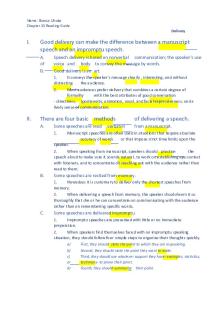Reading Guide 8-12 8-14 PDF

| Title | Reading Guide 8-12 8-14 |
|---|---|
| Course | Organic Chemistry I |
| Institution | University of Maryland Baltimore County |
| Pages | 1 |
| File Size | 63.9 KB |
| File Type | |
| Total Downloads | 68 |
| Total Views | 138 |
Summary
exam 4...
Description
Section 8.12-8.14 Chapter 8 Skills (Learning Objectives on Blackboard): 16-18 End-of-Chapter Problems: 55, 77, 79, 88-89, 91, 93-94 These sections bring everything that we have been discussing in both chapter 7 and chapter 8 together. Specifically, these sections lead you through the process of determining the product(s) of a reaction in which we must first determine what reaction is happening before we predict the products. Recognition of the role of the reagent is extremely important – pay very careful attention to Figure 8.25. Two notes on the author’s classification: CN- is not included. As we have discussed, CN- is a strong nucleophile. It is also a weak base. What category should it be in? t-butoxide ((CH3)3CO-) is a strong base, but it is very hindered. This makes it is a poor nucleophile. What category should it be in? As an aside, notice that it is the localized lone pair (rather than the delocalized lone pair) that acts as a base when DBN eliminates 2-bromopropane on pg 385. These sections are extremely important, but the most important is probably section 8.13. Figure 8.31 summarizes the decision-making process to determine which reaction will happen. Please do not memorize this – it is much more important that you understand it so that you can make critical decisions. This is high level learning, but you can do it. The explanations and discussions should all be comfortable to you if you have really studied and understood the previous discussions of each individual reaction type (SN2, SN1, E2, E1) –and that individual understanding will enable you to draw the correct products once you have determined the appropriate reaction. Go back and revisit the readings/videos for any reactions that you need to review! There is one video available through the WileyPLUS site that compares and contrasts the mechanisms of all four competing reactions (SN1, SN2, E1, E2) – it is worth a look before reading these sections to remind you about the important features of each reaction type. There are three videos available through the Khan Academy site; the first one helps you determine the role of the reagent and the others walk you through some examples of predicting mechanisms and products. Video Mini-Lecture: Drawing Mechanisms for SN1, SN2, E1, and E2 (6:55) – pairs with section 8.13 Recommended Viewing – WileyPLUS Nucleophilicity and Basicity (12:59) – pairs with section 8.12 Recommended Viewing – Khan Academy SN1 SN2 E1 E2 Reactions: Primary and Tertiary Alkyl Halides (9:10) – pairs with sections 8.13, 8.14 Essential Viewing – Khan Academy SN1 SN2 E1 E2 Reactions: Secondary Alkyl Halides (9:10) – pairs with sections 8.13, 8.14 Essential Viewing – Khan Academy...
Similar Free PDFs

Reading Guide
- 11 Pages

Reading guide
- 15 Pages

My Ferrari - 812 Superfast - pc0Llj
- 11 Pages

Chapter 5 Reading Guide
- 9 Pages

The Odyssey Reading Guide
- 1 Pages

Chapter 8 Reading Guide
- 7 Pages

Chapter 15 Reading Guide
- 3 Pages

Chapter 15 Reading Guide
- 2 Pages

Burls Reading Guide
- 10 Pages

Module VI Reading Guide
- 7 Pages

Ch 3 Reading Guide
- 8 Pages

Chapter 13 Reading Guide
- 4 Pages

Ch 3 Reading Guide
- 8 Pages

Chapter 14 Reading Guide
- 2 Pages

Montana 1948 reading guide
- 3 Pages
Popular Institutions
- Tinajero National High School - Annex
- Politeknik Caltex Riau
- Yokohama City University
- SGT University
- University of Al-Qadisiyah
- Divine Word College of Vigan
- Techniek College Rotterdam
- Universidade de Santiago
- Universiti Teknologi MARA Cawangan Johor Kampus Pasir Gudang
- Poltekkes Kemenkes Yogyakarta
- Baguio City National High School
- Colegio san marcos
- preparatoria uno
- Centro de Bachillerato Tecnológico Industrial y de Servicios No. 107
- Dalian Maritime University
- Quang Trung Secondary School
- Colegio Tecnológico en Informática
- Corporación Regional de Educación Superior
- Grupo CEDVA
- Dar Al Uloom University
- Centro de Estudios Preuniversitarios de la Universidad Nacional de Ingeniería
- 上智大学
- Aakash International School, Nuna Majara
- San Felipe Neri Catholic School
- Kang Chiao International School - New Taipei City
- Misamis Occidental National High School
- Institución Educativa Escuela Normal Juan Ladrilleros
- Kolehiyo ng Pantukan
- Batanes State College
- Instituto Continental
- Sekolah Menengah Kejuruan Kesehatan Kaltara (Tarakan)
- Colegio de La Inmaculada Concepcion - Cebu
